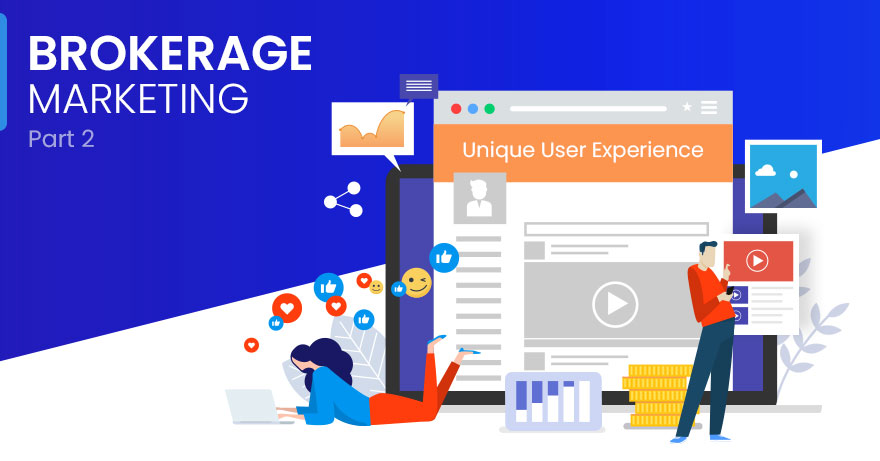
Panda. Brokerage Marketing 101
November 15, 2021
FinTech Trends and the Mobile Trading Moment.
December 14, 2021
Part 2: The Next Steps for Your Brokerage
Welcome back! We concluded Part 1 by drawing attention to the importance of nurturing expertise within the ranks of your company. When all is said and done, inspiring confidence is often the deciding factor between a prospect choosing your services or those of one of your rivals. You want to ensure that whichever part of your business a prospective client comes into contact with, they are met with an experience that makes them feel they’re in good hands.
As we explained in the previous article, you don’t stand a hope of achieving this if your clients know more about the markets you’re offering than your salespeople. The same goes for all the different types of content you put out there, from your homepage to your blog and on to social media; a prospect that sees through your content, or judges it of a low quality, is unlikely to become a loyal customer. With all that in mind, in what follows we’ll go into further depth as to how to step up your marketing efforts with actionable insights that you can start building a plan around today.
Unify Your On-Ramps
It’s so simple, but for some reason you don’t see it employed as often as it should be in our industry. Your Facebook experience looks and feels the same way from the very first time you visit someone else’s page, through to your experience of registering, and on to the creation and use of your own personal profile. The same goes for Amazon, whatever your path was to finding and first using the service, it’s probably pretty much the same experience for you today. In fact, you identify Amazon, Facebook, and any Google product because of the unique user experience that comes with each service.
Why then, does the lead capture on your banner campaigns look and feel different from your website? Why does the platform look different from the client area? In fact, why is the client area separate from the platform in the first place? And while we’re at it, how come there’s no registration or sign-in process directly on the platform itself? Imagine if Amazon, Facebook, or Google forced you to have a registration, sign-in, and account management experience that was completely separate from the main platform. You teach your users how to use your services with every step they take, if these experiences are inconsistent then your retention will be like trying to catch water through a sieve.
Share Information Between Departments
Sharing information is just another way of saying that the software each department uses should not be a walled garden. Instead, it should allow different roles in your organisation to add to the general knowledge your business gathers about each client. So, when your sales/retention manager assigns a client to their hottest agent, they can know beforehand which funnel brought the client in, what asset classes they’re most interested in trading, how experienced or inexperienced they are, even how successful have they been (down to their current PnL).
An organisation in which information flows frictionlessly between departments will always win over time, this is because it retains a higher percentage of clients and thus isn’t exclusively reliant on high client turnover for its revenues. It’s also necessarily smarter than a business that uses a brute force approach to marketing, conversion and retention. Finally, it’s also a business that builds a higher level of brand loyalty and brand ambassadorship among its traders.
Set A Consistent Tone
Every recognisable brand has a unique style and tone it uses to address its client base. It’s important to understand that without that style and tone your marketing efforts are interchangeable with any other brand’s, which is a recurring issue in our industry. Barring a few notable exceptions, content in the online FX/CFD industry is pretty homogenous and has been so for the best part of 15 years.
You can blame this on the copy/paste approach to marketing (see Part 1), or on the fact that our industry has a high turnover in terms of staff, which effectively means that the right people are rarely in the right roles for long enough to create/maintain a recognisable brand identity in terms of style and tone. Remember the style and tone of your content is completely invisible, it can’t be weighed or measured, but it is an important part of a client’s experience of using your services.
It’s important that your organisation pays attention to how it addresses clients, both prospective and existing. Whether it’s the email newsletters you send out, the social media posts you make, or the longer form evergreen content you develop such as trading education, everything you do should have a consistent feel, like your clients are being addressed by the same friendly and knowledgable person.
Cast a Wide Net
While it might seem on the surface that this point contradicts the previous one, it’s completely consistent with it. Casting a wide net is not about throwing a bunch of random marketing initiatives out there, hoping that one sticks. Casting a wide net means that within the style and tone you have created for addressing your clients, you draft a wide range of communications that target different types of users.
Some clients will be blog readers, preferring long form content, others will be social media users who prefer to engage with content that’s short and to the point. Others still will refuse to engage unless the content is audiovisual rather than text-based. They should all be catered for with unique content that’s nevertheless in the same style and tone. If you plan your content creation initiatives correctly, it should also be more efficient, as you can create longer-form content as a template for each subject and then repurpose this content into:
- YouTube scripts
- Social media posts
- Mini-articles
- Banner campaigns
In this way, every piece of content you commission is used in the most efficient way, giving as many different people the opportunity to engage with it.
Talk to Panda!
We’ve refrained from plugging our own products and services throughout this two-part series because we want to get the points across in as objective a manner as is possible. If, however, any of the issues raised in these articles have intrigued you and you’d like to learn more about how to put them into practice, then please don’t hesitate to get in touch, our success management team has you covered.
For free consultation
Request a Call
